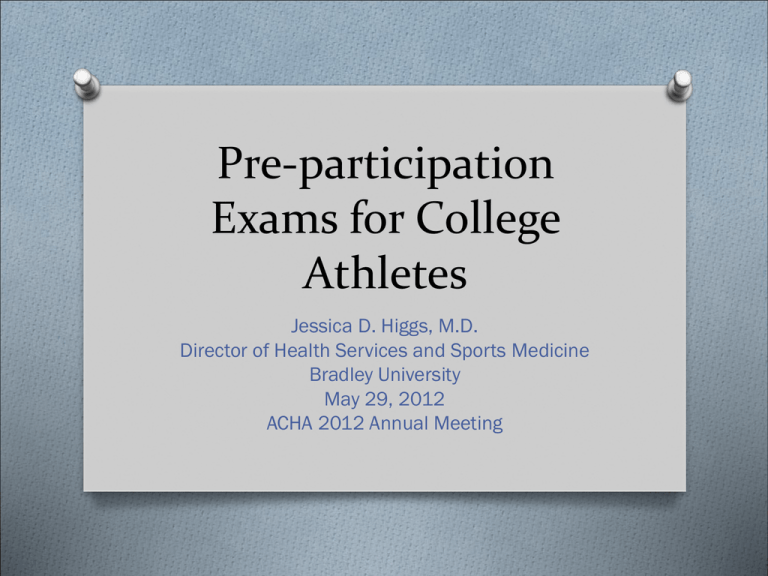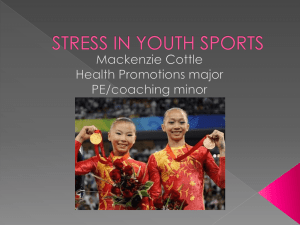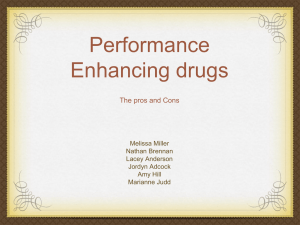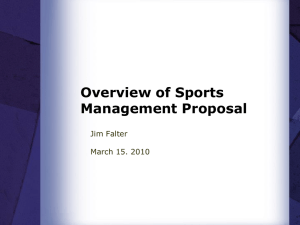
Pre-participation
Exams for College
Athletes
Jessica D. Higgs, M.D.
Director of Health Services and Sports Medicine
Bradley University
May 29, 2012
ACHA 2012 Annual Meeting
Background
O Over 370,000 NCAA athletes
O 60,000 NAIA athletes
O Over 50,000 NJCAA athletes
NCAA
O NCAA sports medicine handbook (adopted by NAIA)
O A pre-participation medical evaluation should be
required upon a student-athlete’s entrance into the
institutions intercollegiate athletics program. This
initial evaluation should include a comprehensive
health history as defined by current CDC guidelines
and relevant physical exam, with strong emphasis on
cardiovascular, neurologic, and musculoskeletal
evaluation. After the initial medical evaluation, an
updated history should be performed annually.
Further pre-participation physical exams are not
believed to be necessary unless warranted.
NJCAA
O PHYSICAL EXAMINATION
O All student-athletes participating in any one
of the NJCAA certified sports must have
passed a physical examination administered
by a qualified health care professional
licensed to administer physical
examinations, prior to the first practice for
each calendar year in which they compete
Section 9, NJCAA Eligibility criteria
AHA
O AHA modified 1996 recommendations for
screening every two years for collegiate
athletes. Revision recommends
cardiovascular screening as part of initial
exam and in subsequent years an interim
history and blood pressure measurement
should be made.
Circulation, 2007
Background
O Poor sensitivity and specificity
O Has no future predictive value
O No study exists that demonstrates a PPE
based on history and physical exam alone is
effective in preventing or detecting athletes
at risk for sudden death
O Evidence category D, expert opinion
Objectives
O List the primary and secondary objectives in
doing a pre-participation physical
O Identify red flags from the history and
physical that would prompt further
evaluation for cardiac concerns
O Describe key components in the evaluation
of a concussion history
O Discuss the different options available for
“clearing” an athlete
Primary Objectives
O Screen for conditions that may be life-
threatening or disabling
O Screen for conditions that may predispose to
injury or illness
O Meet administrative requirements
Secondary Objectives
O Determine general health
O Serve as an entry point to health care
system
O Provide opportunity to initiate discussion on
other health topics
History
O Most important element of the PPE
O History alone detects 88% of medical
conditions and 67% of musculoskeletal
conditions during a PPE
O Questions unproven
O Difficulties in obtaining accurate medical
history
Clinical Journal of Sports Medicine, 2006
Clearance
O 3.1-13.9% of athletes require further evaluation
before final clearance status is determined
O 4 categories
O Cleared for all activities without restriction
O Cleared with recommendations for further
evaluation or treatment
O Not cleared – clearance status to be reconsidered
after completion of further evaluation, treatment,
or rehabilitation
O Not cleared for certain types of sports or for any
sports
Mayo Clinic Proc, 1998
Clearance
O When abnormality found consider the
following
O Does problem increase risk of injury or illness
O
O
O
O
for athlete
Are other participants at risk
Can they safely participate with treatment
Can limited participation be allowed while
treatment being completed
If clearance is denied for some sports, are
other sports safe
O Particular sport issues should be
considered
Sports Classification
O Contact
O Strenuous
Cardiovascular
O
O
O
O
O
O
O
O
O
O
O
O
Have you ever passed out or nearly passed out DURING or AFTER exercise?
Have you ever had discomfort, pain, or pressure in your chest during exercise?
Does your heart race or skip beats during exercise?
Has a doctor ever told you that you have high blood pressure, high cholesterol, a
heart murmur, a heart infection?
Has a doctor ever ordered a test for your heart?
Do you get lightheaded or feel more short of breath than expected during
exercise?
Have you ever had an unexplained seizure?
Do you get more tired or short of breath more quickly than your friends during
exercise?
Has anyone in your family died of heart problems or had any unexpected or
unexplained sudden death before age 50?
Does anyone in your family have hypertrophic cardiomyopathy, Marfan syndrome,
arrhythmogenic right ventricular cardiomyopathy, long QT syndrome, short QT
syndrome, Brugada syndrome, or catecholaminergic polymorphic ventricular
tachycardia?
Does anyone in your family have a heart problem, pacemaker, or implanted
defibrillator?
Has anyone in your family had unexplained fainting, unexplained seizures, or near
drowning?
Cardiovascular Red Flags
O Exertional chest pain
O Exertional syncope or near-syncope
O Unexplained seizures
O Excessive dyspnea or fatigue
disproportionate to the level of exertion
O History or current finding of a murmur
O History or current finding of hypertension
O Family history of death prior to age of 50 in
1st or 2nd degree relative
Cardiovascular
O First sign of cardiac abnormality…..
SUDDEN DEATH
O AHA purpose for screening
O Recommends some form of PPE for college
age athletes
O Ethical, legal, and medical grounds
O 36th Bethesda conference
Incidence
O Exact incidence of SCD in athletes is
O
O
O
O
unknown
Current estimate is between 1:25,000 to
1:200,000
In Italy 1:25,000 prior to national screening
program
US military recruits 1:9000
More common in males, African-Americans,
and basketball and football athletes
JAMA 1996
Annals of Internal Medicine 2004
Sudden Death NCAA
Sudden Cardiac Death
Hosey e al, Sudden Cardiac Death, Clinics in Sports Medicine, 2003
Hypertrophic Cardiomyopathy
O Accounts for about one-third of sudden cardiac
O
O
O
O
O
JAMA 1996
deaths in US athletes younger than 30 years
LV wall thickness of 16mm or more (normal <12,
borderline 13-15mm)
Inherited autosomal dominant disorder
Typically develops in early adolescence to young
adulthood
Only 21% of athletes who died of HCM had signs or
symptoms 36 months prior to their death
Characteristic murmur is harsh systolic ejection
murmur that increases with Valsalva and diminish
with lying supine (present about 25% of time)
Hypertrophic cardiomyopathy
O ECG with be abnormal in 95% of patients
with HCM
O Prominent Q waves
O Deep negative T waves
O Dramatic increases in QRS voltage with ST
depression or T-wave inversion
O Echocardiography remains the standard for
diagnosis of HCM
Circulation 1982
Coronary Artery Anomalies
O Accounts for 17% of cases
O Less than half of SCD cases have prodromal
symptoms
O Exertional syncope, chest pain, palpitations
O Transthoracic echo
NEJM 2003
Myocarditis
O Accounts for 6% of SCD in US athletes
O Coxsackievirus B implicated in 50% of cases
O Also echovirus, adenovirus, influenza, and chlamydia
pneumoniae
O Prodromal viral illness followed by progressive
exercise intolerance, dyspnea, cough, and orthopnea
O ECG – diffuse low voltage, ST-T wave changes, heart
block, or ventricular arrhythmias
O Labs – leukocytosis, elevated ESR, C-reactive protein,
elevated myocardial enzymes
O Echocardiogram
Circulation 2007
Arrhythmogenic Right
Ventricular Cardiomyopathy
O 4% of SCD in United States
O 22% in Veneto region of northeastern Italy
O 68% of athletes had prodromal symptoms
O Syncope, chest pain, palpitations
O Physical exam is normal
O ECG
O Precordial T-wave inversion, epsilon wave,
prolongation of QRS, or RBBB
O Echocardiogram
Circulation 2007
NEJM 1998
Cardiovascular
O Marfan syndrome
O Cardiovascular
complications are
major cause of
morbidity and mortality
O Risk of aortic rupture
or dissection increases
during adolescence
O Ghent criteria
Others
O Aortic Stenosis
O Coronary Artery Disease
O Ion Channel Disorders
O Long QT being most common
Cardiovascular
O Hypertension
O Elevated BP reported in
6.4% of athletes
O Increase in body size
O Use of appropriate charts
and cuffs
O Careful evaluation for
secondary causes including
CMP, hematocrit, UA and
ECG
Medicine and Science of Sports and Exercise 2004
Physical Exam
O Auscultation for murmurs
O Both supine and standing positions (or with
valsalva manuever)
O Palpation of femoral pulses to exclude aortic
coarctation
O Examination for the physical stigmata of
Marfan syndrome
O A brachial artery blood pressure taken in the
sitting position
EKG
Discussion
EKG - Pro
O Makes the clinical evaluation more effective
O Poor incidence/prevalence data
O 1:200,000 or 1:25,000 or 1:43,000
O False positive rate claims too high
O Claim up to 20% new tool from University of
Washington has data to significantly reduce
O Similar to mammograms
O Cost
O Similar to HIV, HPV screening
O Feasibility
O YH4L here in Chicago perfect example of mass
screening
AMSSM 2012
EKG - Con
O No argument that increases the potential dx of
HCM, AV accessory pathway, RVCM, Burgada,
LQTS
O Unknown prevalance
O What is the magnitude?
O Does more harm that good?
O Inappropriate invasive and expensive studies
O Unnecessary athletic restriction
O Is asymptomatic same as symptomatic?
O Italy’s best rate is our current rate of SCD
AMSSM 2012
Neurologic Conditions
O Have you ever had a head injury or
O
O
O
O
O
concussion?
Have you been hit in the head and been
confused or lost your memory?
Have you ever had a seizure?
Do you have headaches with exercise?
Have you ever had numbness, tingling, or
weakness in your arms or legs after being
hit or falling?
Have you ever been unable to move your
arms or legs after being hit or falling?
Definition
O A trauma-induced
alteration in mental
status that may or
may not be
accompanied by a
loss of consciousness
Neurology 1997
Definition
O Complex pathophysiological process affecting the brain,
induced by traumatic biomechanical forces. Several
common features that incorporate clinical, pathological,
and biomechanical injury constructs that may be used
in defining the nature of concussive head injury include:
O May be caused by direct blow to the head, face, neck, or
O
O
O
O
elsewhere on the body with an “impulsive” force transmitted to
head
Rapid onset of short lived impairment of neurological function
that resolves spontaneously
Neuropathological changes but the acute clinical symptoms
largely reflect a functional disturbance rather than structural
injury
Graded set of clinical syndromes that may or may not involved
loss of consciousness
Grossly normal structural neuroimaging studies
Prevalence
O 300,000 to 2 million sports related concussions
annually
O 40,000 in high school level
O Football accounting for 63%
O Sports with highest incidence of concussion in
high school
O Football, ice hockey, soccer, wrestling, basketball, field
hockey, baseball, softball, volleyball
O Estimated that 36% of college students will report
a history of multiple concussions
Collins et Al, JAMA 1999
Collins et al, Neurosurgy 2006
Observable Symptoms
O Loss of consciousness
O Poor coordination
O Impact seizure
O Gait unsteadiness
O Slow to answer questions
O Easily distracted
O Vacant stare
O Retrograde amnesia
O Posttraumatic amnesia
O
O
O
O
O
(anterograde)
Unusual or inappropriate
emotions
Vomiting
Slurred speech
Personality changes
Inappropriate or
decreased playing ability
Reported Symptoms
O Headache
O Changes in sleep pattern
O Nausea
O Impaired concentration
O Dizziness
O Irritability
O Double or blurred vision
O Sensitivity to light and
noise
O Ringing in ears
O Feeling “foggy”
O Amnesia
Pathophysiology
O “metabolic mismatch”
O Cells exposed to changes in intracellular and
extracellular environment
O Results in hyperglycolysis
O Increased Na/K ATP-ase activation
O Decreased cerebral vascular flow
O Possibly due to accumulation of endothelial Ca
Post-concussive Syndrome
O Condition arising after a “head injury” that
produces deficits in three areas of CNS
functioning
O Somatic (neurological)
O Psychological
O Cognitive
O Occurs in 38% to 80% of people who
experience “mild head trauma”
O Majority of people recover fully in 4-6
months
O Only 7-15% have symptoms 1 year after
injury
Post concussive Syndrome
O Cognitive
O Verbal and nonverbal memory impairment, attention deficit
O Somatic
O Headache, dizziness, blurred vision, sensitivity to light or
sound
O Psychiatric
O Personality changes, irritability, anxiety, and/or
depression, apathy
O Female gender, socioeconomic status, 40+,
psychological disorder, prior head injury, headache
history
Second Impact Syndrome
O Believed to occur when an athlete who has
sustained a head injury sustains a second
one prior to complete resolution of the first
O Athlete may walk of the field, then collapse,
become semi-comatose, dilate pupils, and
respiratory failure
O Believed to be due to loss of auto-regulatory
function of the brain’s blood supply
O Precise incidence cannot be determined
O More than 50% mortality and 100%
morbidity
Concussion History
O
O
O
O
O
O
O
O
O
O
O
How many previous head injuries has the athlete experienced?
How did it occur?
What type of symptoms?
How long did each last?
Was there retrograde or posttraumatic amnesia?
How long were they held from practice?
Did they miss any competitions?
Did they have difficulty in their classes?
Were their grades typical for them that semester?
How long did it take them to feel 100%?
Are there other hits to the head that were not considered
concussions?
Neurologic Conditions
O Seizures
O Athletes with good seizure control can participate
in both collision and contact sports
O Hx of new onset or after head injury deserves
further review
O Headaches
O Burners or stingers
O 52% college football players annually
O Determine isolated or recurrent
O Cervical cord neurapraxia
O Cervical spine radiographs
Neurologic Conditions
O Cervical cord neurapraxia
O Cervical spine radiographs
Medical History
O Has a doctor ever denied or restricted your
participation in sports for any reason?
O Only 1-2% of athletes completely disqualified
O Do you have an ongoing medical condition?
O Big picture of athletes general health
O Assess control and affect of sport
Drugs and Supplements
O Are you currently
taking any
prescription or
nonprescription (over
the counter)
medicines or pills?
O Double check medical
history
O Affect performance or
banned from certain
sports
Allergies and Anaphylaxis
O Do you have allergies to medicines, pollens,
foods, or stinging insects?
O DO THEY CARRY EPI-PEN???
Paired Organs
O Were you born without or are you missing a
kidney, an eye, a testicle, or any other
organs?
O In general, absence of a paired organ does
not limit the athlete from competing
O Risks and ramifications of injury to remaining
organ must be discussed
Viral Illnesses
O Have you had infectious mononucleosis
within last month?
O Splenomegaly is almost universally present in
patients who have confirmed mono
O “Palpable spleen”
O Sports and other physical activities should be
avoided for 21-28 days after infection starts
per AAFP
Heat Illness
O When exercising in the heat, do you have severe
muscle cramps or become ill?
O Ascertain if they vomited, fainted, cramped, went to
the ED, got an IV, take any supplements, and how
much they drink before, during, and after games
O Anticipatory guidance, other prevention measures,
and treatment strategies
O Young age, poor aerobic fitness, inadequate
acclimatization, history of heat illness, dehydration,
equipment that inhibits heat loss, excess body fat,
febrile condition, overexertion, high humidity,
diuretics, caffeine, antihistamines, SSRI,
neuroleptics, methylphenidate, ephedra
Prevention – 11 controls
O
O
O
O
O
O
O
O
O
O
O
AMSSM 2012
Rest and recovery
Proper hydration
Knowledge of PMH
Modify for environmental conditions
Phase in activity (Heat acclimization)
Nutritional supplements
Health and safety plan
Red flags
Encourage activity before practice
Change the culture
Keep the athletes cool
Sickle Cell
O Has a doctor told you that you or someone in
your family has sickle cell trait or sickle cell
disease?
O Focus on sickle cell TRAIT
O 1/16 AA, 1/183 Hispanic, 1/625 Caucasians
O US Armed Forces reported more than 20-fold
increase in risk of death among recruits with
sickle cell trait engaged in strenuous activity
O Heat, dehydration, higher altitudes
O NCAA requires testing in Division I and II,
strongly recommended in Division III
NEJM 1997
Summary Slide from AMSSM
O
O
O
O
O
O
O
O
O
targeted screening of high-risk groups;
aggressive educational intervention for athletes with SCT and
those who supervise them;
allowing appropriate time and access for hydration of athletes;
gradual acclimation to novel activity and the heat;
modification of activity in the heat and at altitude;
appropriate strength and conditioning programs developed by
qualified strength and conditioning coaches;
punitive exercise and conditioning sessions be prohibited;
early recognition of athletes who are struggling, so they can
immediately be allowed to rest and not pushed past their
physiologic limit;
adequate emergency planning for all individuals responsible for
athletes during training and conditioning.
Harmon KG, Drezner JA , Casa DJ: To screen or not to screen for sickle cell trait in American
football? British Journal of Sports Medicine March 2012 .
Eyes and Vision
O Have you had any problems with your eyes
or vision?
O Vision MUST be assessed at time of PPE
O Do you wear glasses or contact lenses?
O Do you wear protective eyewear, such as
goggles or a face shield?
O 42,000 eye injures related to sports in 2000 and
more than 50% occurred in those under age 15
O Baseball and basketball have highest risk
O Athletes with best corrected visual acuity in 1 eye
worse than 20/40 are considered “functionally
one-eyed”
Sports and Recreation Eye Injuries, US Consumer Product Safety Commission 2000
Respiratory
O Has a doctor ever told you that you have
asthma or allergies?
O Do you cough, wheeze, or have difficulty
breathing during or after exercise?
O Is there anyone in your family who has
asthma?
O Have you ever used an inhaler or taken
asthma medicine?
Respiratory follow-up
O Where do you keep your inhaler?
O Have you ever missed practice or games
because of your asthma?
O Have you gone to the hospital because of
asthma during the past year?
O Do you smoke?
Respiratory
O 1 in 15 children has asthma per National
Asthma Education and Prevention
Program
O Exercise-induced asthma has a
prevalence of 10-50% in adolescents
O Symptoms or history alone fail to
accurately identify persons with asthma
or EIA 45.8% of the time
O Subtle symptoms such as headaches,
abdominal pains, muscle cramps, fatigue,
dizziness, feeling “out of shape”
Respiratory Testing
O Peak expiratory flow rates after exercise
O Spirometric testing
O May be negative in some athletes
O Could be helpful to test in sporting
environment
O Exercise provokes symptoms in previously
diagnosed, poorly controlled asthma
Respiratory Testing
O Peak expiratory flow rates after exercise
O Spirometric testing
O May be negative in some athletes
O Could be helpful to test in sporting
environment
O Exercise provokes symptoms in previously
diagnosed, poorly controlled asthma
Respiratory
O Short-acting beta-agonists 20-30 minutes
before exercise
O Long-acting beta-agonists and leukotriene
inhibitors effective, especially for all day
activities
O Peak flow should be at least 80% of
personal best before participating
O KEEP INHALER CLOSE BY!!!
Dermatologic Conditions
O Do you have any rashes, pressure sores,
or other skin problems?
O Have you had a herpes skin infection?
O Skin conditions result in 15% of lost wrestling
practice time
O PPE gives opportunity to discuss signs and
symptoms of infections
O Herpes gladiatorum, tinea gladiatorum, tinea
pedis, MRSA, scabies, molluscum contagiosum,
impetigo, furunculosis, carbunculosis
Musculoskeletal Injury
O Have you ever had an injury, like a sprain, muscle, or ligament
O
O
O
O
O
O
O
O
tear, or tendinitis, that caused you to miss a practice or game?
Have you had an broken or fractured bones or dislocated
joints?
Have you ever had a stress fracture?
Have you had a bone or joint injury that required x-rays, MRI,
CT, surgery, injections, rehab, PT, a brace, a cast, or crutches?
Have you ever been told that you have or have you had an x-ray
neck (atlantoaxial) instability?
Do you regularly use a brace or assistive device?
Do you have a bone, muscle, or joint injury that bothers you?
Do any of y our joints become painful, swollen, feel warm, or
look red?
Do you have any history of juvenile arthritis or connective
tissue disease?
Musculoskeletal Injury
O Elicit responses regarding more serious
injuries with long-term consequences
O Duration of brace use
O Stress fractures
O Female triad, poor training techniques, alignment
O Atlantoaxial instability
O 15% of children with Down’s syndrome
O Almost all asymptomatic
O Space >5mm between posterior aspect of the
anterior arch of the atlas and the odontoid
O Special Olympics mandates radiographic
screening
Nutritional Concerns
O Are you happy with your weight?
O Are you trying to gain or lose weight?
O Has anyone recommended you change your
weight or eating habits?
O Do you limit or carefully control what you
eat?
Nutritional Concerns
O Disordered eating
O Spectrum of unhealthy nutritional behaviors
O Poor nutritional habits, calculated calorie
deprivation, self-induced vomiting, laxitive
use, diuretic use, anorexia nervosa, bulimia,
overeating
O Wrestling, crew, judo gymnastics, figure
skating, diving, dancing, cheerleading,
distance running
O Most common among female athletes (10:1)
Pathology
O Women at greater risk than men
O Associated with alteration of endocrine
function surfacing as abnormal menstrual
patterns
O 50% of female runners may have irregular
menses
O 5 menses or less per year increases frequency of
stress fractures to 49% compared to 29% with
regular menses
O Fewer than 10 menstrual cycles demonstrate
higher incidence of stress reactions
Kaeding, Management and Return to Play of Stress Fractures, Clin J Sport Med 2005
Female Triad
O Amenorrhea or menstrual irregularities
O Eating disorders, including binging/purging,
diet pills, diuretics/laxatives
O Osteoporosis (BMD more than 7.5 SD below
the mean value for young adults)
BMI
O BMI is a tool for weight status and correlates
with body fat
O BMI less than 5th percentile for children or
18.5 for adult is underweight
O BMI greater than 95th percentile
O Individual consideration of body habitus is
required
Menstrual History
O Have you ever had a menstrual period?
O How old were you when you had your first
menstrual period?
O Primary or secondary amenorrhea or
oligomenorrhea
O Disordered eating, pregnancy, other
gynecologi or metabolic conditions
O Hypermenorrhea or polymenorrhea
O How many periods have you had in the
last 12 months?
O Statistics show fewer than 10 periods a
year…
Anemia
O Iron deficiency anemia vs. low ferritin
O 30-50ng/ml
O Ferrous iron better than ferric iron for
absorption
O Ascorbic acids and meat proteins enhance
O Tannins, calcium, antacids, and whole grains
can decrease absorption
Current Sports Medicine Report 2009
General Concerns
O Do you have any concerns that you would
like to discuss with a doctor?
O Only time physician gets time with some
adolescents
O Discussions about stress, depression, feeling
safe, tobacco, alcohol, steroids or other
supplements, drugs, sex, guns, seatbelt use
are all appropriate
Other screening questions
O Do you feel stressed out or under a lot of pressure?
O Do you ever feel sad, hopeless, depressed, or
O
O
O
O
O
anxious?
Do you feel safe at your home or residence?
Have you ever tried cigarettes, chewing tobacco,
snuff, or dip?
Do you drink alcohol or use any other drugs?
Have you ever taken anabolic steroids or used any
other performance supplement?
Do you wear a seat belt, use a helmet, and use
condoms?
Immunizations
Physical
BMI
O Obesity is most prevalent nutritional
disorder among children and adolescents in
US
O Significant reduction in life span
O 21-24% overweight, 10% obese
O Increased 50-60% in a single generation
Schwarz, 2009
HEENT
O Visual acuity
O Snellen, 20/40 in each eye
O Pupils
O anisocoria
O Oral cavity
O Ears
O Nose
Exam
O Cardiovascular
O BP
O Palpation, Auscultation
O Various maneuvers
O Respiratory
O Normal exam does not exclude EIA
Exam
O Abdomen
O Masses
O Hepatosplenomegaly
O Genitalia
O Presence of both testicles
O Testicular irregularities
O Inguinal canal hernias or pain
O Testicular cancer leading cause of cancer
deaths 1-35 year olds
O Female exam not part of PPE
O Tanner staging also not recommended
Skin
O Acne
O Sun damage
O Rashes
O Infections
O Illicit drug use
O Infestations
O Abnormal nevi
Exam
O Musculoskeletal
O Basic screening exam recommended
O Full joint exam for previous injury
O Sport specific exam
O Neurologic
O Cognitive
O Sensorimotor
PPE Screening MS Exam
Clearance Status
O Cleared without restriction
O Cleared, with recommendations for further
evaluation
O Not cleared until further evaluation
O Not cleared for certain or all sports
Sports Classification
O Contact
O Strenuous
Cardiovascular
O 36th Bethesda Conference
O Hypertension
O >18
O stage 1, all categories
O Stage 2 or end organ damage, no competitive
sports until blood pressure is evaluated and
treated
O <18
O 99th percentile or evidence of end-organ damage,
similar to stage 2 above
O 90th-99th percentile may be cleared to participate
while undergoing additional tests
Benign functional murmurs
O Do not preclude participation
O MVP
O Not restricted from high-intensity sports
unless accompanied by one of the following
O
O
O
O
O
History of syncope due to arrhythmia
Family hx of sudden death
Prior embolic event
Arrhythmia worsened by exercise
Moderate to marked mitral regurgitation
O If present, a low intensity sports may be
considered
Hypertrophic cardiomyopathy
O Unequivocal diagnosis of HCM should NOT
be allowed to participate in competitive
sports
O No published literature for ICDs for primary
prevention in patients considered low risk
for sudden death who want to play sports
Dermatologic
O Presence of any open wound or infectious
skin condition that cannot be protected
warrants exclusion from competition
O Specific requirements for return to play can
be obtained from NFHS and NCAA
MRSA
O Prevention is key
O Cover all infected wounds with occlusive dressing
O Universal precautions for all wound care
O Frequent hand washing with antibiotic soap
O Showering WITH SOAP before and after practice
sessions and games
O Disposable towels and alcohol based hand
sanitizers on field
O Prohibit sharing of equipment
O RTP
O Must be covered with clean dressing
O Some sports require 72 hrs on antibiotics prior to
return
Diabetes
O Carefully screened for the following
O Cardiovascular – level of activity determined
by primary treating physician
O Retinopathy – restricted for weight lifters and
high impact activities (jogging)
O Nephropathy – strenuous activity most likely
restricted on case by case basis
O Peripheral neuropathy – limit to low impact
on feet (bicycling or swimming)
O Gastroparesis – limit safe participation in
strenuous or prolonged activities due to fluid
and electrolyte absorption
Diabetes
O Due to risk of hypoglycemia the following
sports should only be approved after
careful discussion
O
O
O
O
O
O
O
Rock climbing
Skydiving
Scuba diving
Ultramarathons
Cycling
Open-water swimming
Motor sports
Diabetes
O ADA guidelines for regulating blood glucose
in athletes with type 1 diabetes
O Metabolic control before exercise
O Avoid exercise if blood glucose >250 with ketosis
present or if blood glucose >300
O Ingest added carbohydrate if glucose <100
O Blood glucose monitoring before and after
exercise
O Identify when changes in insulin or food intake are
necessary
O Learn gycemic response to different exercise conditions
O Food intake
O Carbohydrate-based foods should be readily available
during and after exercise
Pre-participation issues
O Routine stable blood glucose control
O HgbA1C less than 7
O Routine self monitoring 2-3 times a day
O Complications
O Evaluation of BP, neurologic function, joint
mobility, skin condition
O Specifically evaluate feet for ulcers
O Recent retinal examination
O Screening lab values for lipids and kidney
disease
Pre-participation issues
O Requirements for
athlete
O Recognize early
warning signs of
hypoglycemia
O Have a strategy for preexercise and
postexercise
alterations
O Medic-alert bracelet
O Provision of glucagon
Game Time issues - BS
O Under 100
O Should not participate in activity, give carbs and recheck in
15-30 minutes
O 100-150
O Able to participate, should eat 15g carbs prior to game
O 150-250
O Able to participate, does not need to supplement carbs if
has eaten in last 30-60 minutes
O 250-300
O Check for ketones in urine, if present unable to participate,
give sliding scale insulin, if not present able to participate
O Over 300
O Unable to participate until sugar is lowered and ketones
are no longer present
Sport-specific Considerations
O Track and field – timing of events
O
O
O
O
O
unpredictable
Football – Variable levels of exertion
Outdoor winter sports – insulin may freeze
Scuba diving, rock-climbing – once
contraindicated
Water sports – additional risk of drowning
Boxing, Judo, and karate still somewhat
reserved
Eating Disorders
O Athletic participation should be restricted
when there is evidence of compromised
performance or threatens health
Eyes
O Essential to consider eye protection for
athletes with already impaired vision in 1
eye
O Sports in which eye protection cannot be
effectively worn are contraindicated for 1
eyed athletes
O Athletes with eye conditions should be
referred to ophthalmologist for complete
evaluation and clearance
O Athletes identified with abnormal visual
acuity should be referred to eyecare
professional
Gynecologic
O No restrictions for females with 1 ovary
O Menstrual disorders may be cleared while
further evaluation is underway
O If pregnancy suspected, clearance for
contact-collision or strenuous sports
participation should be held
Heat Illness
O Clearance should not be denied but specific
prevention strategy should be implemented
O History of heat stroke or rhabdomyolysis
merit further investigation
Abdomen
O Hepatomegaly
O all sports avoided until resolution
O Splenomegaly from mono – resolution of
symptoms, current recommendation 28
days
O Manual exam unreliable
O Problems with ultrasound exam too
O Inguinal hernia
O Asymptomatic may participate in all sports
Nephrologic
O Special consideration given to the
athlete with a single functioning kidney
O Controversy if kidney is pelvic, iliac, or
multicycstic, shows evidience of
hydronephrosis or ureteropelvic junction
abnormalities
O Should not play in contact-collision sport
O Full explanation given to the athlete including
protection, potential long-term
consequences, and treatment of injuries
Musculoskeletal
O Participation may be possible in activities
that do not directly affect injured site
O Sprains, subluxation, dislocation
O
O
O
O
O
Effusion, swelling, inflammation
Ligamentous instability of affected joint
Decreased ROM
Strength less than 85-90%
Loss or alteration sport-specific functional ability
O Strains or muscle contusions
O Previous three above
Musculoskeletal
O Overuse injuries
O Criteria similar to acute sprains or strains
O Education about proper training
O Fractures
O Determined by treating physician
O Location and type of fracture, risk of reinjury,
effect of treatment
O Rules in specific sports concerning padded
and unpadded material
O Developmental conditions
O Spinal deformities, apophysitis
Neurologic
O Concussion
O Multiple concussion classification and
management protocols
O Symptom checklists and neuropsychological
testing
O Symptomatic individuals should NEVER be
cleared for participation
O Second impact syndrome
Neurologic
O Burners and Stingers
O History may be cleared for all sports if asymptomatic
and physical exam is normal
O Recurrent episodes or persisting symptoms require
evaluation with cervical spine radiographs and
additional imaging to rule out predisposing condition
O Cervical disk disease, foraminal stenosis, cervical
spinal stenosis
O Transient quadriparesis
O Evaluated by a spine subspecialist
O Findings of ligamentous instability, cord injury or
edema, or prolonged symptoms should be excluded
from participation in contact sports
O For all others including congenital or acquired
cervical spinal stenosis, RTP controversial
Neurologic
O Seizure disorders
O Treated or controlled seizure disorder can
participate in nearly all sports
O High risk – gymnastics, high diving, skydiving,
motor sports, rock climbing
O Poorly controlled condition
O Clearance deferred for contact-collision, limited
contact, and potentially hazardous noncontact
sports such as archery, riflery, swimming,
weightlifting, height sports
Others
O Obesity
O Medications
O Pulmonary
O HIV/Hepatitis
Conclusions
O PPE continues to evolve, especially in the areas
of cardiovascular risk reduction and syncope
O Recommendations for the use of ECG and
echocardiography continue to evolve
O Issues pertaining to screening, the accuracy of
the screening questions in predicting who may
be at risk, and predictability of exam findings
need to be studied
O Provider should serve as an educator and
advocate for a healthy, active lifestyle
Questions?
References
O
O
O
O
O
O
O
O
O
O
O
O
Maron et al, Recommendations and considerations related to preparticipation screening for cardiovascular
abnormalities in competitive athletes: 2007 update: a scientific statement from the American Heart
Association Council on Nutrition, Physical Activity, and Metabolism. Circulation. 2007;115(12):1643-1455
Chun et al. The relative contributions of the history and physical examination in the preparticipation
evaluation of a collegiate student-athlete. Clin J Sport Med. 2006;16(5):437-438
Smith et al. The preparticipation physical examination; Mayo Clinic experience with 2,739 examinations.
May Clin Proc. 1998;7395):419-429
Maron et al. Sudden death in young competitive athletes. Clinical, demographic, and pathological profiles.
JAMA 1996;276(3):199-204
Eckart et al. Sudden death in young adults: a 25-year review of autopsies in military recruits. Ann Intern
Med. 2004; 141(11):829-834
Maron et al. Sudden death in hypertrophic cardiomyopathy: a profile of 78 patients. Circulation.
1982;65(7):1388-1394
Maron. Sudden death in young athletes. N Engl J Med. 2003;349(11):1064-1075
Corrado et al. Screening for hyertrophic cardiomyopathy in young athletes. N Engl J Med.
1998;339(6):364-369
DiFiori et al. Preparticipation evaluation of collegiate athletes. Med Sci Sports Exerc. 2004;36(5):S102
Kark et al. Sickle-cell trait as a risk factor for sudden death in physical training. N Engl J Med.
1987;317(130):781-787
Rodenburg et al. Iron as an ergogenic aid: ironclad evidence? Crr Sports Med Rep. 2007;6(4):258-264
Schwarz. Obesity. https://www.emedicine.com/ped/topic1699.htm#section~bibliography







